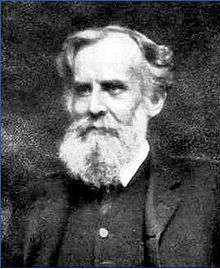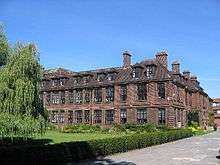John Venn
| John Venn | |
|---|---|
 | |
| Born |
4 August 1834 Kingston upon Hull, Yorkshire, England |
| Died |
4 April 1923 (aged 88) Cambridge, England |
| Nationality | English |
| Fields |
Mathematics Logic[1] Philosophy |
| Institutions | University of Cambridge |
| Alma mater | University of Cambridge |
| Notable awards | Fellow of the Royal Society |
|
Signature | |
John Venn, FRS,[2][3] FSA,[4] (4 August 1834 – 4 April 1923) was an English logician and philosopher noted for introducing the Venn diagram, used in the fields of set theory, probability, logic, statistics, and computer science.


Life and career
John Venn was born on 4 August 1834 in Kingston upon Hull, Yorkshire to Martha Sykes and Rev. Henry Venn, who was the rector of the parish of Drypool. His mother died when he was three years old.[5] Venn was descended from a long line of church evangelicals, including his grandfather John Venn.[6]Venn was brought up in a very strict atmosphere at home. His father Henry had played a significant part in the Evangelical movement and he was also the secretary of the ‘Society for Missions to Africa and the East’.
He began his education in London joining Sir Roger Cholmeley's School,[7] now known as Highgate School, with his brother Henry in September 1846. He moved on to Islington proprietary school and in October 1853 he went to Gonville and Caius College, Cambridge.[4][8] In 1857, he obtained his degree in mathematics and became a fellow. In 1903 he was elected President of the College, a post he held until his death.[8] He would follow his family vocation and become an Anglican priest, ordained in 1859, serving first at the church in Cheshunt, Hertfordshire, and later in Mortlake, Surrey.[9]
In 1862, he returned to Cambridge as a lecturer in moral science, studying and teaching logic and probability theory, and, beginning around 1869, giving intercollegiate lectures. These duties led to his developing the diagram which would eventually bear his name.
I began at once somewhat more steady work on the subjects and books which I should have to lecture on. I now first hit upon the diagrammatical device of representing propositions by inclusive and exclusive circles. Of course the device was not new then, but it was so obviously representative of the way in which any one, who approached the subject from the mathematical side, would attempt to visualise propositions, that it was forced upon me almost at once.— John Venn[10]
In 1868, he married Susanna Carnegie Edmonstone with whom he had one son, John Archibald Venn.
In 1883, he resigned from the clergy, having concluded that Anglicanism was incompatible with his philosophical beliefs.[8] In that same year, Venn was elected a Fellow of the Royal Society and was awarded a Sc.D. by Cambridge.
He died on 4 April 1923.
Memorials
- Venn is commemorated at the University of Hull by the Venn Building, built in 1928
- A stained glass window in the dining hall of Gonville and Caius College, Cambridge, commemorates Venn's work.
- In commemoration of the 180th anniversary of Venn's birth, on 4 August 2014, Google replaced its normal logo on global search pages with an interactive and animated Google doodle that incorporated the use of a Venn diagram.[11]
- In 1866, Venn published The Logic of Chance, a ground-breaking book which espoused the frequency theory of probability, offering that probability should be determined by how often something is forecast to occur as opposed to “educated” assumptions. Venn then further developed George Boole's theories in the 1881 work Symbolic Logic, where he highlighted what would become known as Venn diagrams.
Publications
Venn compiled Alumni Cantabrigienses, a biographical register of former members of the University of Cambridge.[12] This work is still being updated online, see #External links, below. His other works include:
- "Consistency and Real Inference". Mind. 1 (1). January 1876.
- Symbolic Logic. London: Macmillan and Company. 1881. ISBN 1-4212-6044-1.
- "On the Employment of Geometrical Diagrams for the Sensible Representation of Logical Propositions". Proceedings of the Cambridge Philosophical Society. 4: 47–59. 1880.
- The Logic of Chance: An Essay on the Foundations and Province of the Theory of Probability, with Especial Reference to Its Application to Moral and Social Science (First ed.). London and Cambridge: Macmillan. 1866.. Two further editions were published[13][14]
- Caius College. London: F. E. Robinson & Company. 1901.
- Caius, John (1904). John Venn, ed. The Annals of Gonville and Caius College. Printed for the Cambridge Antiquarian Society, sold by Deighton, Bell & Co.
- Annals of a Clerical Family: Being Some Account of the Family and Descendants of William Venn, Vicar of Otterton, Devon, 1600–1621. Cambridge: Cambridge University Press. 1904. ISBN 978-1-108-04492-9.
- On Some of the Characteristics of Belief. London and Cambridge: MacMillan an Co. 1870.
Notes
- ↑ Venn 1880.
- ↑ Anon 1926.
- ↑ Pickles 2004.
- 1 2 Gibbins 2004.
- ↑ Famous-mathematicians.com.
- ↑ School of Mathematics 2003.
- ↑ Highgate School Roll 1833–1912, Unwin Brothers Ltd 1913
- 1 2 3 Duignan 2014.
- ↑ Soylent Communications 2014.
- ↑ Edwards 2004.
- ↑ Antonimuthu 2014.
- ↑ Venn 1922.
- ↑ Venn 1876.
- ↑ Venn 1888.
References
- Anon (1926). "Obituary Notices of Fellows Deceased: Rudolph Messel, Frederick Thomas Trouton, John Venn, John Young Buchanan, Oliver Heaviside, Andrew Gray". Proceedings of the Royal Society A: Mathematical, Physical and Engineering Sciences. 110 (756): i–v. doi:10.1098/rspa.1926.0036.
- Anon. "John Venn – Mathematician Biography, Facts and Pictures". Famous-mathematicians.com. Retrieved 3 August 2014.
- Anon (October 2003). "Venn biography". School of Mathematics and Statistics University of St Andrews, Scotland. Retrieved 3 August 2014.
- Duignan, Brian (22 May 2014). "John Venn (English logician and philosopher)". Encyclopedia Britannica. Retrieved 3 August 2014.
- Edwards, A. W. F. (2004). Cogwheels of the Mind: The Story of Venn Diagrams. JHU. p. 3. ISBN 9780801874345.
- Pickles, John D. (2004). "'Venn, John Archibald (1883–1958)', Oxford Dictionary of National Biography". Oxford University Press. doi:10.1093/ref:odnb/40972.
- John R. Gibbins, ‘Venn, John (1834–1923)’, Oxford Dictionary of National Biography, Oxford University Press, 2004; online edn, May 2006 "Venn, John (1834–1923), philosopher and antiquary". The Oxford Dictionary of National Biography. 2004. doi:10.1093/ref:odnb/36639.
- Antonimuthu, Rajamanickam (2014). "John Venn Google Doodle". YouTube.
- Soylent Communications (2014). "John Venn". Retrieved 3 August 2014.
- Venn, J. (1880). "I.On the diagrammatic and mechanical representation of propositions and reasonings". Philosophical Magazine Series 5. 10 (59): 1–18. doi:10.1080/14786448008626877.
- Venn, John (1922). Alumni Cantabrigienses: A Biographical List of All Known Students, Graduates and Holders of Office at the University of Cambridge, from the Earliest Times to 1900. Cambridge: Cambridge University Press.
- Venn, John (1876). The Logic of Chance: An Essay on the Foundations and Province of the Theory of Probability, with Especial Reference to Its Logical Bearings and Its Application to Moral and Social Science (Second ed.). Macmillan.
- Venn, John (1888). The logic of chance: an essay on the foundations and province of the theory of probability, with especial reference to its logical bearings and its application to moral and social science, and to statistics (Third ed.). Macmillan.
External links
- A Cambridge Alumni Database
- The Venn archives clarify the confusing timeline of the various Venns.
- Obituary of John Venn (New York Times)
- Portrait of Venn by Charles Brock, and a link to a site about Venn
- Another (clearer) view of the Venn stained glass window
- John Venn at Find a Grave